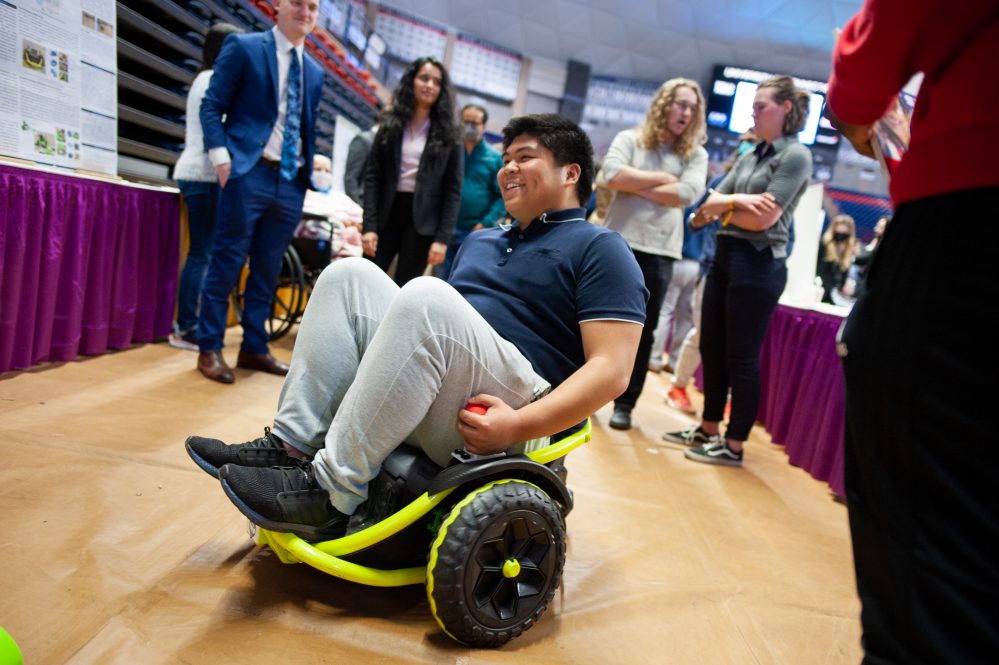The University of Connecticut’s Nursing and Engineering Innovation Center, one of the first of its kind in the nation, will advance health care, workforce, and economic development through interdisciplinary collaborations, positioning Connecticut to be a global leader in health care technology innovation.
Nurses interact with patients daily and see where there are gaps in care. Nurses are also taught to be problem solvers, adapting as necessary to fix unique health issues. Engineers are technically trained and up to date on the latest technology. Engineers typically also thrive in creating new devices to improve the quality-of-life for end users.
What happens when you combine the two professions together? UConn’s Schools of Nursing and Engineering believe it will lead to fresh ideas and inventions that will directly impact patients’ lives in a positive way. The four focal areas of the new Center are research, education, community engagement, and technology transfer.
The Center is under the co-direction of Tiffany Kelley, Ph.D., MBA, RN-BC, Visiting Professor and Director of the School of Nursing’s Healthcare Innovation Online Graduate Certificate Program and Leila Daneshmandi, Ph.D., Assistant Professor in Residence in Innovation and Entrepreneurship and Director of the entrepreneurship Hub (eHub) in the School of Engineering.
“Engineers are trained to solve problems and create solutions. They have the technical knowledge, skills, and abilities to actualize new technologies,” Daneshmandi says. “By partnering with nurses and health care professionals, who have deep contextual knowledge of on-site problems and needs, we can ensure that our innovations are user-centric and designed for unmet health care needs.”
In its initial phase, the Center includes the creation of joint educational programs for students and seed grants for collaborative research among faculty.
The deans of the two Schools, who will oversee the Innovation Center throughout its development with assistance from an Advisory Board, expect this first phase to take two to three years. The goal of the second phase is to create a shared state-of-the-art research and teaching facility, which will require major University, state, federal, or donor investment.
“We are joining forces to not only support our research activities, but to also expand student learning and have a greater impact on patients and employers across Connecticut,” says former School of Nursing Dean Deborah Chyun.
Not only could prototypes be field-tested and exhibited in such a facility, but it would also further integrate established undergraduate- and graduate-level programs at the two Schools, helping to meet the increasing demand for workers in both fields.
“The School of Engineering has strong connections in health care, especially through our Biomedical Engineering Department operated with UConn Health,” says Engineering Dean Kazem Kazerounian. “With this new Innovation Center, however, we’re investing in patient-focused care at the hands of the talented nurse workforce.”
The Nursing and Engineering Innovation Center is not the first instance of collaboration between the two Schools. Researchers affiliated with the School of Nursing’s Center for Advancement in Managing Pain belong to both Schools and are actively involved in shared training and research activities. Several interdisciplinary teams have also submitted grant applications for collaborative projects.
Among other collaborations, School of Nursing associate professor Ruth Lucas worked with Engineering faculty to design her Breastfeeding Diagnostic Device, which measures infants’ sucking during breastfeeding. Ellen Quintana ’21 (NUR) worked with engineering students to design the now-patented ReduSeal glove waste reduction system. In the spring of 2022, students at both Schools built hundreds of Corsi-Rosenthal Boxes, which are do-it-yourself air purifiers that aid in filtration during COVID-19.
“The Nursing and Engineering Innovation Center is a natural progression of ongoing collaborations that have been ongoing for the last several years” Kelley says. “We are excited to see how it will enhance our research and educational programs, help meet the demand for our graduates in the workforce, and provide better care for patients. It is amazing what we can do with a little seed funding, enthusiasm, and determination.”
The creation of the center was inspired by a bequest from James Belmont ’86 (ENG), who wanted to demonstrate his appreciation for his UConn education and that of his sister, Gail Belmont-Harwood ’81 (NUR). Belmont’s support for the Center’s Program Support Fund stems from the siblings’ understanding that best practices in innovation development indicate the need for end users to be involved in the design of new products. Registered professional nurses are the largest group of health care professionals today, totaling about four million, and 10 times the number of physicians.
In addition to support from Belmont and Belmont-Harwood, the Nursing and Engineering Innovation Center received supportive funds from both schools, the Provost’s Office, the Office of the Vice President of Research, and a $30,000 VentureWell Courses and Programs grant to support collaborative Nursing and Engineering undergraduate education advancement in this area. The VentureWell grant was awarded to fund a fellowship program for students from Nursing and Engineering to come together and work on health care technological solutions.
Opportunities to support the Center can be made through the Nursing Innovations Fund.
For more information, please connect with Daneshmandi or Kelley. Please visit the new Center website.



